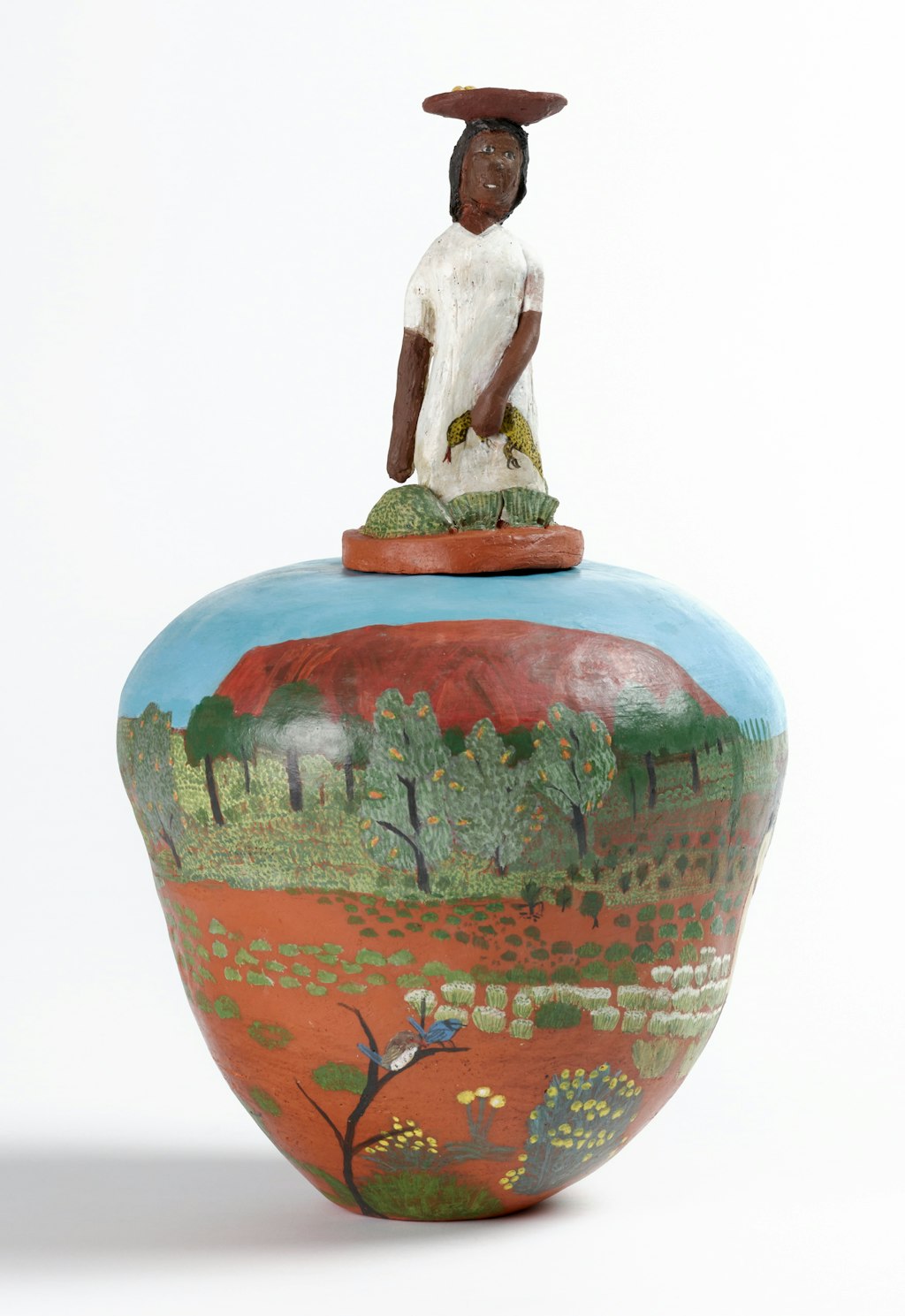Hayley Panangka Coulthard

Hayley Panangka Coulthard Rama-rama nukanha yia (My great-great-grandmother’s story) © the artist
Rama-rama nukanha yia (My great-great-grandmother’s story)
Hayley Panangka Coulthard is among a group of Western Aranda artists known as the Hermannsburg Potters, who are influenced by the painting style of Albert Namatjira (1902–59). Namatjira was a pioneer of the Hermannsburg school of watercolourists at Ntaria/Hermannsburg.
This terracotta pot with a figurative lid tells the story of Coulthard’s Pitjantjatjara rama-rama (great-great-grandmother) Florrie. The painted landscape on the pot depicts Mutitjulu, the remote Aboriginal community where Florrie was born. At 18, Florrie ran away from Mutitjulu, because she did not want to marry. Florrie walked a long way, settling in Ntaria, where she eventually married a Western Aranda man. For the lid, Coulthard has sculpted Florrie holding her coolamon, which she used to collect bush foods to eat on her journey.
A two-time Wynne finalist, Coulthard says she did not initially make this work for exhibition, ‘but when I finished [it], I wanted to find a way to share Florrie’s story for all the Hermannsburg family, so I entered it in the Wynne Prize’.
-
K–6 discussion questions
This terracotta pot depicts Mutitjulu, a remote Aboriginal community in the Northern Territory where the artist’s great-great-grandmother Florrie was born. Locate Mutitjulu on a map and research images of the area. What similarities to this place can you see in Coulthard’s pot? Look closely at the subject matter, colours, material and forms.
Coulthard is one of the Hermannsburg Potters, a group of artists whose pottery is known for its unique forms and depiction of distinct Central Australian Country, culture and values. One of the characteristics of Hermannsburg pots is the relationship of the sculptural lid to the painted body. What do you think the relationship between the lid and body are in this work?
How do you think your response to this artwork and to the story it tells would be different if it was painted on canvas with acrylic paint?
-
K–6 activities
This terracotta pot with a figurative lid tells the story of Coulthard’s Pitjantjatjara rama-rama (great-great-grandmother) Florrie. Read about Florrie in the artist’s statement above and then research the story of your own great-great grandmother or someone from the past who is important to you. Present their story to your class.
Using terracotta clay, Coulthard uses hand-coiling and pinch techniques to create her works. Research these techniques and think about the process of making this work and the skills involved. Practice these ceramic techniques with clay or playdough. Which method do you prefer, and why?
-
7–12 discussion questions
Like Coulthard, many Hermannsburg Potters tell stories connected to their life and family history in their works. Look at these two earlier pots in the Art Gallery’s collection: Esther Ngale Kennedy Marsupial mouse pot 1997 and Judith Pungarta Inkamala Thepa Mapa 2018. What do you notice about their approaches compared to Coulthard’s? Think about what stories are being shared, and how.
-
7–12 activities
Observe this work in context with other terracotta pots by Hermannsburg artists in the Art Gallery’s collection. What stylistic features unite them? Think about what stories are being told and how Coulthard’s story of her great-great-grandmother sits within them. Create your own vessel or container that tells your story. For the design, think about what you want to communicate to your audience about you, your family and the place you live in.